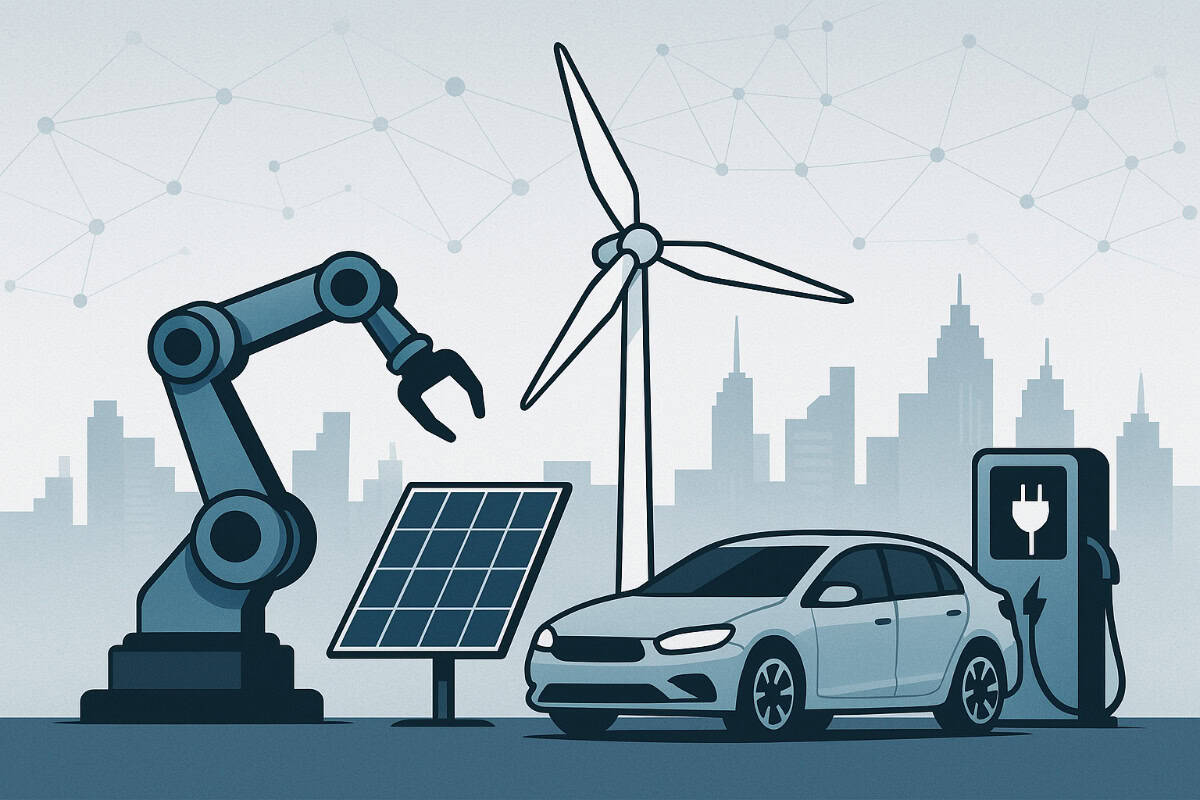TL;DR
From artificial intelligence and robotics to renewable energy and PropTech, the fastest-growing industries are transforming how we work and live. These sectors are expanding rapidly due to technological innovation, shifting consumer demands, and global challenges. As they evolve, they present new career paths, demand fresh skills, and offer significant potential for long-term economic and employment growth.
Table of Contents
The world is on the brink of a new industrial age, with a plethora of sectors poised for unprecedented growth. As technology advances and global needs evolve, industries once considered futuristic are now at the forefront, leading transformations across various fields.
Setting the Stage for Future Growth
Growing industries are a testament to the dynamic shifts in our global economic landscapes. As society evolves, there is a pressing need for innovative solutions to complex challenges. For instance, the post-construction contracting market is forecasted to hit $2,112.71 billion by 2026, driven by rising demand in skilled trades.
Key Factors Fueling Growth:
- Technological Advancements: Including machine learning and advanced technologies.
- Healthcare Sector: Aiming to improve patient outcomes and address growing demands.
- Renewable Energy: Emphasizing sustainability and the transition to electric vehicles.
In Europe, industries thrive through digital transformation and an evolving regulatory environment. Education and collaboration in emerging fields, alongside investment in research and development, are vital for nurturing innovation and growth.
Adapting to these changes is necessary for individuals, businesses, and governments. Embracing new business models and career opportunities will pave the way for economic and employment growth. As consumer demands shift, the ability to stay agile and informed will be essential. This collective adaptability will set the stage for future prosperity across fast-growing industries.
Artificial Intelligence and Machine Learning: Revolutionizing Problem-Solving
Artificial Intelligence (AI) and Machine Learning are revolutionizing problem-solving across various industries. These fast-growing industries see rapid technological advancements, shaping healthcare, consulting, and transport. AI is increasingly part of our daily lives, driving automation and smart robotics in sectors like healthcare, manufacturing, and logistics.
Key Statistics
| Market | Projection |
|---|---|
| AI Market | $2,575.16 billion by 2032 |
| Europe's AI and Robotics | €250 billion by 2030* |
Industries Impacted by AI
- Healthcare: Enhancing patient outcomes and treatment efficiency.
- Manufacturing: Fueling rapid growth with automated production.
- Logistics: Streamlining operations through smart robotics.
AI's influence is changing economic landscapes, leading to new business models and career opportunities. As AI applications grow, the need for skilled professionals to develop and apply these technologies increases. The integration of AI into various sectors promises a future of innovation and efficiency, making it an essential part of economic growth and employment.
Renewable Energy: Powering a Sustainable Future
Renewable energy is reshaping the global economic landscape with its rapid growth. Europe is leading this green revolution. The renewable energy market in Europe is projected to grow from €213 billion in 2022 to over €350 billion by 2030. This boom aligns with the European Union's goal for 32% of energy to come from renewable sources by 2030.

Factors driving this growth include government incentives, declining costs, and technological advancements. Solar power, in particular, is seeing significant growth as part of this transformation.
Here are some key data points:
| Year | Europe Renewables Market Size (€ Billion) |
|---|---|
| 2022 | 213 |
| 2030 | 350+ |
The international renewable energy market was valued at around $1.21 trillion in 2023. It is expected to grow at an annual rate of 17.2% from 2024 to 2030.
This booming industry offers diverse career opportunities and plays a crucial role in combating climate change. As it evolves, advanced technologies and strategic investments will continue to shape its future.
Healthcare Innovations: Telemedicine and Wearables
Telemedicine and wearables are transforming the healthcare industry. These innovations enable remote consultations and real-time health monitoring, which improve efficiency in diagnoses and empower both medical professionals and patients. The rise of telemedicine, especially post-COVID-19, showcases its importance in the healthcare sector.
Benefits of Telemedicine:
- Convenient access to medical services
- Cost reduction for patients and providers
- Enhanced patient outcomes through timely care
The telemedicine market is on a rapid growth trajectory. It's expected to soar with a compound annual growth rate (CAGR) of 17.2% from 2023 to 2030. By 2030, the market could expand from $87.41 billion in 2022 to a whopping $286.22 billion.
North America leads this booming industry, holding a 47.87% market share in 2022. Pioneering companies like Teladoc and MDLive play a crucial role in this growth.
Telemedicine and wearable tech address changing consumer demands and offer new career opportunities in the healthcare sector. As wearables keep evolving, they help enhance patient care through advanced technologies, crucially changing economic landscapes.
Fintech: Redefining Financial Services
The fintech industry is transforming financial services with technology. Innovations in payments, lending, and investing are driving the rapid growth of this sector. Mobile banking and digital payments play a key role, while blockchain-based solutions add to the expansion.
Here are some leading companies in fintech:
- Desert Financial Credit Union
- Northern Trust
- Achieve
- Vensure Employer Solutions
These companies are pioneers in creating new financial products and services. AI-powered financial planning tools are also reshaping the industry. They improve efficiency, transparency, and make financial management more accessible.
Investing in fintech startups offers great opportunities as the industry adapts to meet consumer demands. The sector's evolution is powered by technological advancements and changing economic landscapes.
Key Components of Fintech Growth:
| Component | Impact |
|---|---|
| Mobile Banking | Enhances accessibility of banking services |
| Digital Payments | Facilitates faster and secure transactions |
| Blockchain-Based Solutions | Increases transparency and reduces fraud risks |
| AI-Powered Financial Planning | Improves financial management efficiency |
As the fintech industry continues to evolve, it plays a crucial role in reshaping how financial services are delivered and consumed worldwide.
E-commerce and Digital Retail: The Online Shopping Boom
The e-commerce industry has seen rapid growth due to the pandemic. Digital shopping trends are on the rise, with mobile commerce leading the charge. Personalized shopping experiences and seamless logistics are now key focuses.
Key trends include:
- Cross-border sales: More brands are selling across borders.
- Direct-to-Consumer models: These are becoming more popular.
Massive investments are being made in:
- Digital platforms
- Warehouse automation
- Last-mile delivery solutions
The e-commerce sector is poised for continued growth, projecting to lead well into 2025 and beyond. The table below highlights critical industry developments:
| Development Area | Focus |
|---|---|
| Mobile Commerce | Enhanced mobile shopping experiences |
| Personalized Experience | Tailored suggestions and offers |
| Seamless Logistics | Smooth purchase-to-delivery processes |
| Cross-Border Sales | Expanding sales across different countries |
| Direct-to-Consumer | Eliminating middlemen for better customer relations |
E-commerce is not just about buying online. It is reshaping business models, driven by changing consumer demands and advanced technologies. With a focus on efficiency and personalization, the industry is setting the stage for ongoing dominance.
Cybersecurity: Safeguarding the Digital Realm
Cybersecurity is a booming industry experiencing rapid growth due to increased digitalization and rising cyber threats. This growth is prompting businesses and governments to heavily invest in advanced security solutions. The market is expanding at a swift pace, with Europe's cybersecurity industry projected to grow from €38 billion in 2022 to €70 billion by 2027, reflecting a 12.5% CAGR.
From 2023 to 2030, the global cybersecurity market is expected to see a 12.3% CAGR. This is driven by the urgent need to address escalating cybercrimes while enhancing safety measures. As the digital landscape becomes more interconnected, the demand for skilled cybersecurity professionals is skyrocketing.
Key Careers in Cybersecurity:
- Data Protection
- Threat Analysis
- Ethical Hacking
Average Salary: £54,000 (UK)
Job opportunities in cybersecurity are expanding worldwide, presenting exciting career paths. These roles are crucial in countering evolving threats and ensuring secure digital environments. Thus, the cybersecurity industry plays a crucial role in safeguarding the digital realm, offering substantial economic growth and a wide range of career opportunities.
Robotics and Automation: Enhancing Manufacturing Efficiency
Robotics and automation are transforming the manufacturing industry. With increased use of AI and capital investment, these technologies are on the rise. North America and Asia Pacific, in particular, are seeing a boom in these industries. Japan is leading the way with robot-run and automated restaurants, showcasing their potential.
Technological advancements such as Industry 4.0 and advanced robotics are driving robust growth in the U.S. manufacturing sector. These innovations improve efficiency, reduce costs, and increase productivity. In Europe, the AI and robotics industry is expected to grow at a CAGR of 16.4%, reaching €250 billion by 2030.
Key Benefits of Robotics and Automation:
- Efficiency: Faster production times and fewer errors.
- Cost Savings: Lower labor and production costs.
- Flexibility: Adaptable manufacturing processes.
In summary, robotics and automation are crucial to the rapid growth of the manufacturing industry. Their impact is felt across the globe, from North America to Asia Pacific. Embracing these technologies offers significant career opportunities and boosts economic growth. As demands evolve, industries must adapt swiftly to maintain a competitive edge.
Biotechnology: Breakthroughs in Healthcare and Agriculture
Biotechnology is one of the fastest-growing industries, boasting a projected CAGR of 13.96% from 2023 to 2030. This rapid growth is fueled by technological advancements in healthcare, such as personalized medicine and drug development.
Key Industry Players:
- AstraZeneca
- Johnson & Johnson Services, Inc.
- Novartis AG
- Pfizer, Inc.
Government support plays a crucial role in the sector's expansion, modernizing regulatory environments and streamlining approval processes. The healthcare industry benefits from biotechnology's innovations, which improve patient outcomes and address consumer demands.
Asia Pacific is poised for the fastest growth in this booming industry between 2024 and 2030. Advanced technologies in biotechnology also transform agriculture, offering solutions to global challenges like food security and sustainable farming.
Biotechnology's Major Contributions:
- Enhanced patient care through personalized medicine.
- Improved drug development procedures.
- Sustainable agricultural practices.
As the biotechnology sector evolves, career opportunities abound across a wide range of fields, from research and development to healthcare and agriculture. This rapid growth signals positive shifts in economic landscapes worldwide.
Online Learning: Education in the Digital Age
Online learning is revolutionizing education. The digital education industry is set to grow rapidly, with a compound annual growth rate of 25.8%. By 2030, its value could soar from $19.2 billion in 2023 to $95.7 billion.

Key Drivers of Growth:
- Higher internet access worldwide.
- Need for ongoing skill development in a changing job market.
- COVID-19's push towards remote learning boosted digital education's rise.
Trends:
- Online and hybrid learning environments are becoming the norm.
- There's a growing demand for educators skilled in technology-enhanced teaching.
Major Players:
- Coursera, Inc., started by Stanford professors, reported $523.76 million in revenue for 2022. This shows the significant role of online platforms.
The table below outlines the growth of the digital education sector:
| Year | Market Value ($ billion) |
|---|---|
| 2023 | 19.2 |
| 2030 | 95.7 |
This vibrant sector is transforming traditional education models, meeting consumer demands, and opening wide-ranging career opportunities. The rapid growth is creating new business models and adjusting to the dynamic regulatory environment. As technology advances, online learning will play a crucial role in shaping future education.
Real Estate Technology: Transforming Property Management
Real Estate Technology, or PropTech, is reshaping how we buy and manage properties. Using advanced property management software and online marketplaces, PropTech innovations like virtual tours and smart home technology are creating smoother, more efficient experiences. These changes serve both consumers and industry professionals by making processes easier and faster.
Key Innovations in PropTech
- Virtual Tours: Offers a convenient way to view properties online.
- Smart Home Technology: Enhances home functionality and efficiency.
- Online Marketplaces: Simplifies the home buying and selling process.
The rapid growth of PropTech is driven by rising consumer demands for seamless real estate experiences. As a result, this sector is poised for significant expansion by 2025.
For those looking to engage in a fast-growing industry, PropTech offers numerous career opportunities. It plays a crucial role in transforming traditional real estate operations, providing new business models and improving economic landscapes.
In summary, the future looks bright for PropTech as it continues to innovate and meet the needs of modern real estate.
Embracing Innovation for Future Opportunities
The fastest-growing industries are reshaping economic landscapes through technological advancements. Innovations such as artificial intelligence, machine learning, and advanced technologies are playing a crucial role in this transformation. As businesses adopt new business models, they can better meet changing consumer demands.
To keep up, individuals should focus on continuous learning. Online courses and upskilling can open new career opportunities and improve patient outcomes in the healthcare sector. The manufacturing industry is also seeing a rapid growth rate due to automation and machine learning.
Governments have a crucial role in supporting these booming industries by creating favorable regulatory environments. Investment in infrastructure will enable sectors like the renewable energy sector and electric vehicles to thrive.
A collaborative approach among businesses, governments, and educational institutions can drive further development. This collaboration can address labor shortages, particularly in fast-growing industries like the construction industry and financial services.
By embracing innovation, we prepare for the future. This means capitalizing on economic growth and employment growth prospects in a wide range of sectors. It's not just about keeping pace with change but leading it for an equitable future across regions like the Asia Pacific and beyond.

